Dar Urtatim: Medieval Egyptian Knitting 1 |
|
The oldest surviving knitted socks exhibit some sophistication, with stranded knit polychrome patterns, worked at a gauge of around 12 stitches/10 rows per inch. All were knitted from the toe up of cotton. Both heel shaping and toe formation are created in a variety ways. Some are just two colors: white and dark indigo blue; others are white, light-medium blue, and dark blue. |
My First Authentically-Based Socks
Because I'm such a novice, I decided to make my first pair based on modern directions, from Nancy Bush's Folk Socks. Because experienced knitters say that cotton is trickier to knit with than wool, as it is not springy like wool, I will wait until I have more experience to make a reproduction pair (I already bought the cotton). I used wool-blend yarns, since pure wool gives me a rash. My first pair is white and blue (actually an ombre/space-dyed yarn in shades from dark indigo blue to grey-blue). Ultimately, I didn't follow the book's directions, as they are only for ankle socks, and Bush gives the patterns in a different order than they are on the original sock. But I used the charted patterns and the photo of the Egyptian sock (illustrated above, in Bush, and in Rutt) as guides to make as similar a pair as I could. When i scanned them, my stockings had thin ribbed tops, as they which were in Bush's directions, but I have since ripped out the ribbing, as they are not on the original, and finished it with a bit more plain knitting and a chain stitch tie. As you can also see, the original has a different number of repeats in some areas than mine. This is because I wanted my socks to fit me. If I'd made the same number of repeats they wouldn't have. I made technically authentic short row heels, although I didn't knit them in the horizontal stripes of the original because I wanted a solid area of the blue (i think it looks nice). Bush gives directions for vertically striped heels, I don't know why. I also didn't follow Bush's directions for the toe. Instead I attempted to recreate the star toe as it is on the original.
The bands of Kufic script on the toe, ankle, and top say, "Allah". Yes, as you can see, this is authentic, and what real Muslims wore, at least somewhere between the 11th and 14th centuries, so it wasn't blasphemous. For complete directions with charts for making the authentic blue-and-white knee high socks. |
My Second Authentic Technique Socks
I didn't use cotton yarns, as I was waiting until I got the techniques down, as I heard that cotton was more difficult to control than wool. I used the white wool-cotton blend and the same kind of wool-blend (DK weight Shepherd Sock from Lorna's Laces) as in my first pair, but in a different colorway, graduated shades of light blue to light toast to warm tan to pale muted peach. I used a toe and an inset heel that were different techniques than the toe and heel of my first pair, as found in an authentic Medieval Egyptian stocking pictured in both Rutt and Gibson-Roberts. I included an authentic Arabic Kufic knitting pattern that says "baraka", that is, "blessings". My process was rocky. First I tried to follow the directions for some kind of cast-on toe, but I couldn't get the hang of it, and ripped it out repeatedly. Then I started by making a circle of yarn with a longish tail. Then with a fine crochet hook, I afghan single crocheted eight loops, transferring two at a time to 4 double pointed knitting needles. Some old needles from Eastern Europe, where the people continue the traditions of Muslim knitting, have a point at one end and a hook at the other. This would have been a handy set to have, but I made do with the tools I have. According to descriptions of one authentic historic sock, this is how it was started. At this point I had 8 stitches evenly distributed on 4 needles. I began knitting with the fifth needle. The next trick was to determine how many to increase, how often to increase and how many stitches to have total. I decided I wanted the total to be a multiple of 8, as many patterns are 8 stitch, or multiple of 8 stitch, repeats. Next, how did I want to make my increases? I began by making one yarn-over between the two original stitches on each needle. This made two problems. First, yarn-overs leave lacy holes, which I don't want in my toes. And second, I ended up working on a base of three stitches, which was the wrong multiple. After knitting quite a few rounds, I decided I didn't like how it looked. So I ripped out the whole thing and started over.
So I ripped it all out and started again... I ripped out the toe and all my rows of knitting at least 5 times until I was happy with how I was casting on and increasing. In the end, I basically increased 2 stitches every other row until I had 72 stitches. Then I continued knitting without increasing, knitting in patterns, until the foot of the sock reached pretty far up my instep. It was then that I discovered that I had knit the band of Arabic writing that fills the foot in mirror image because I followed the chart the right-handed way and I knit left-handed. It didn't dawn on me until I was almost done with the 16 pattern row, and after all that other ripping out, I was not going to tear it out. I just knit it the correct way in the bands on the leg. Then I taught myself to knit an inset heel. It was pretty easy. Next, I got to work on the rest of the leg, and this time I knit that Kufic band the correct way... For complete directions with charts for making the invented blue-brown-and-white ankle socks. |
Bibliography
Nancy Bush. Folk Socks.
Priscilla A. Gibson-Roberts. Ethnic Socks.
Richard Rutt. A History of Hand Knitting. |
|
For complete directions with charts for making the authentic blue-and-white knee high socks. For complete directions with charts for making the invented blue-brown-and-white ankle socks. Back to The Knitting Room in Dar Urtatim Back to al-Riyad, the Courtyard at Dar Urtatim, for other Textile and Costume stuff... Questions? Comments? Suggestions?
You can write to me here. |
|
To see another modern pair of Medieval Egyptian knit socks based on a different historic example: |
Text and my sock, copyright by me, Urtatim al-Qurtubiyya bint 'abd al-Karim al-hakim al-Fasi, 1999
Black and white photo, scanned and altered by me for clarity, from the Textile Museum, Washington, D.C. and copyright held by that institution
This page modified 29 April 2006.
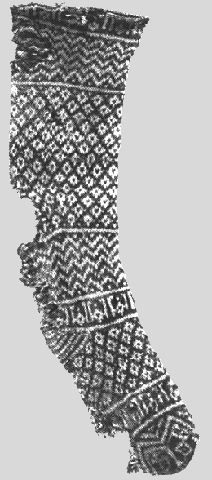
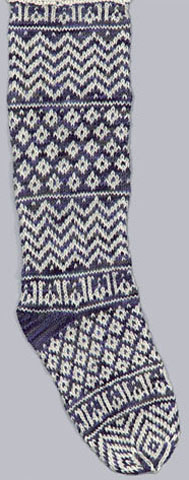
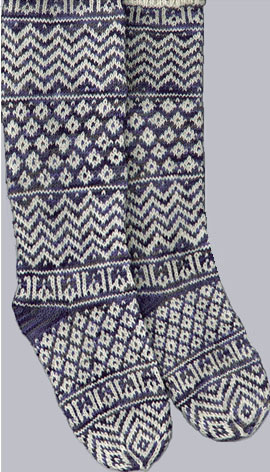 I'm completely self-taught - I learned to knit from books - and to further complicate things, I'm left-handed, so my method of knitting is a bit eccentric. The only other knitting I've done is some slip-stich pattern patches for an old sweater and a plain stockinette shawl. As for historical or semi-historical knitting, so far I have completed the pair of stockings, one of which is shown above, a second pair of anklets, a cotton pouch, and I'm currently making Medieval Muslim mittens.
I'm completely self-taught - I learned to knit from books - and to further complicate things, I'm left-handed, so my method of knitting is a bit eccentric. The only other knitting I've done is some slip-stich pattern patches for an old sweater and a plain stockinette shawl. As for historical or semi-historical knitting, so far I have completed the pair of stockings, one of which is shown above, a second pair of anklets, a cotton pouch, and I'm currently making Medieval Muslim mittens.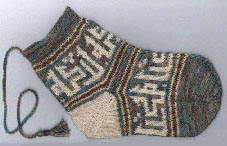 I knit my second pair in the more authentic manner from the toe up. I didn't follow any directions, nor did I base them on an extant pair of socks. Because I had no teacher to work with, I made them up as I went, referring to pattern charts in Bishop Rutt's book and authentic techniques in Gibson-Roberts' book, so I could learn new methods and get some practice.
I knit my second pair in the more authentic manner from the toe up. I didn't follow any directions, nor did I base them on an extant pair of socks. Because I had no teacher to work with, I made them up as I went, referring to pattern charts in Bishop Rutt's book and authentic techniques in Gibson-Roberts' book, so I could learn new methods and get some practice.
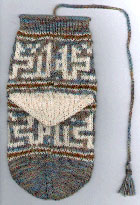 Starting with the same base, this time I increased two stitches per round on each needle, to maintain the base of 8 stitches. On my first round, on the first needle I knit the first stitch, then knit one into the crochet slip-stitch below the first stitch, knit one into the crochet slip-stitch below the second stitch, and knit into the second stitch. I did this on all needles, so I have 16 stitches. On the second round I knit all round. Third round I knit the first stitch, increasing by knitting one into the strand between the first and second stitches of the row below, knit all the rest of the stitches except the last one. I increased again by knitting one into strand between the penultimate and last stitch on the needle, then knit the last stitch on the needle. This seemed ok, so I knit like this on every row until I had 88 stitches total. But it looked wrong, as I had increased every row.
Starting with the same base, this time I increased two stitches per round on each needle, to maintain the base of 8 stitches. On my first round, on the first needle I knit the first stitch, then knit one into the crochet slip-stitch below the first stitch, knit one into the crochet slip-stitch below the second stitch, and knit into the second stitch. I did this on all needles, so I have 16 stitches. On the second round I knit all round. Third round I knit the first stitch, increasing by knitting one into the strand between the first and second stitches of the row below, knit all the rest of the stitches except the last one. I increased again by knitting one into strand between the penultimate and last stitch on the needle, then knit the last stitch on the needle. This seemed ok, so I knit like this on every row until I had 88 stitches total. But it looked wrong, as I had increased every row.